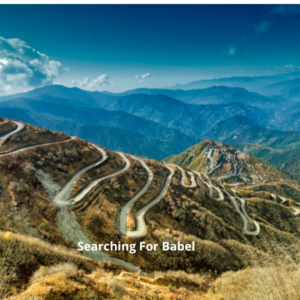Looking For Babel Part Three – The Quarry & The Architect
 “Life lies before us, like a huge quarry lies before the architect; he doesn’t deserve the name of architect except when, out of this fortuitous mass, he can combine with the greatest economy and fitness and durability some form – the pattern of which originated in his spirit (Goethe, Wilhelm Meister’s Apprenticeship, Book 8).”
“Life lies before us, like a huge quarry lies before the architect; he doesn’t deserve the name of architect except when, out of this fortuitous mass, he can combine with the greatest economy and fitness and durability some form – the pattern of which originated in his spirit (Goethe, Wilhelm Meister’s Apprenticeship, Book 8).”
The Quarry:
‘Everyone on earth had the same language and the same words.
And as they migrated from the east, they came upon a valley in the land of Shinar and settled there.
The Architect:
‘They said to one another, “Come, let us make bricks and burn them hard.”—Brick served them as stone, and bitumen served them as mortar.
Not Howard Roark(The Fountainhead):
‘And they said, “Come, let us build us a city, and a tower with its top in the sky, to make a name for ourselves; else we shall be scattered all over the world.” (Bereishis 11:1-4)’
******
The Tower of Babel did not begin as a construction project.
It began with a brick making festival. The first such festival recorded in the Bible.
They wanted to make bricks, which they correctly considered a step forward on their path to creative independence.
Something then stunted their Creative growth spurt:
‘‘And they said, “Come, let us build us a city, and a tower with its top in the sky, to make a name for ourselves; else we shall be scattered all over the world.”
“Rules?” said Roark. “Here are my rules: what can be done with one substance must never be done with another. No two materials are alike. No two sites on earth are alike. No two buildings have the same purpose. The purpose, the site, the material determine the shape. Nothing can be reasonable or beautiful unless it’s made by one central idea, and the idea sets every detail. A building is alive, like a man. Its integrity is to follow its own truth, its one single theme, and to serve its own single purpose. A man doesn’t borrow pieces of his body. A building doesn’t borrow hunks of its soul. Its maker gives it the soul and every wall, window and stairway to express it (Ayn Rand, The Fountainhead).”
The consequence, ‘Let us, then, go down and confound their speech there, so that they shall not understand one another’s speech.”
Thus the LORD scattered them from there over the face of the whole earth; and they stopped building the city (11:7–8),” was forced creativity; the only proper response to their controlled creativity was a Silk Road of Exploration and Discovery.
******
If we understand the Dor HaPilaga – Generation of Dispersion as planting seeds of creativity all over the world, how then shall we look backward into the wanderings of Noah, Cain, and Adam?
How do we understand the future wanderings of Abraham, Jacob, Josef, and the forty-year journey of the Children of Israel in the desert?
Will it influence our understanding of our exile to all four corners of the globe?



